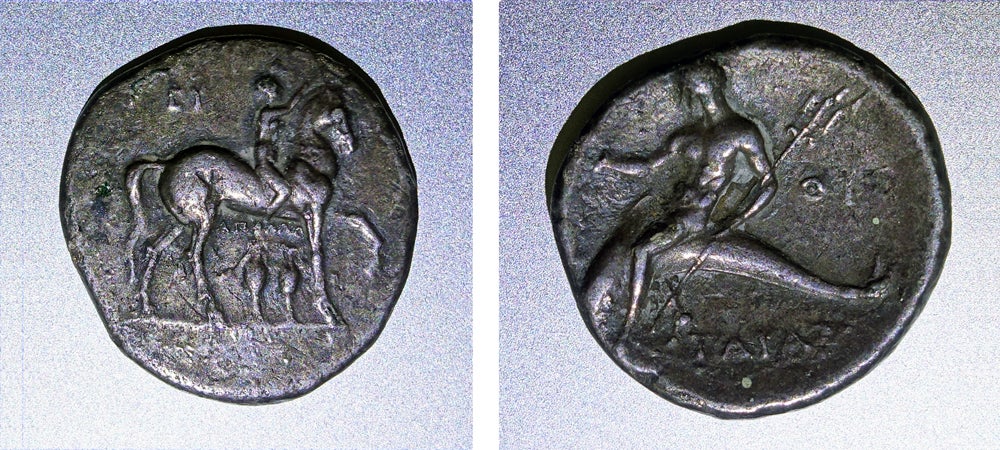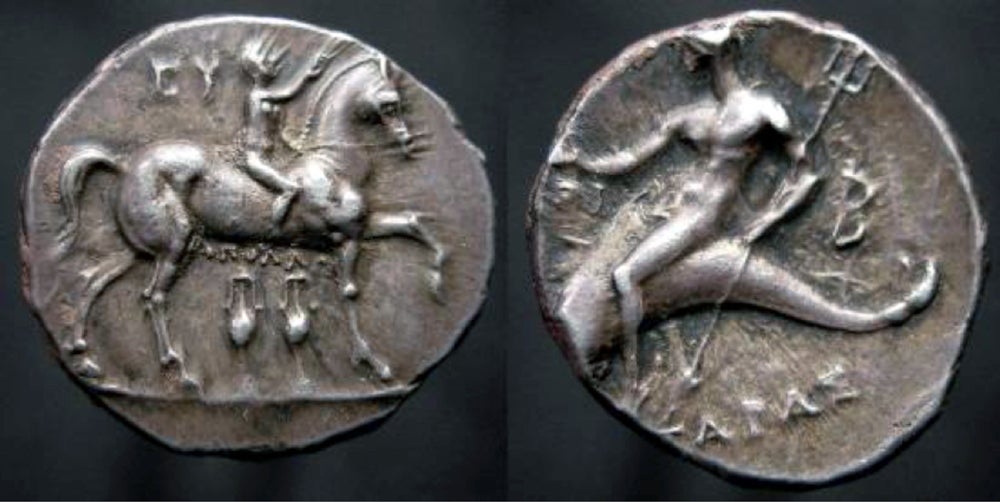 Taras or Tarentum, in Calabria, Southern Italy (300-280 BCE)
Taras or Tarentum, in Calabria, Southern Italy (300-280 BCE)
Naked boy on horseback crowning horse with wreath, Taras Anked, Riding on Dolphin with Trident
6.13 g silver AR didrachm, 22 mm
Provenance: Historical Real Treasures (Agustin A Garcia B – ANA R-3120473)
Coppola Collection
Unconfirmed information: “very hard to find; Vlasto 766 (same dies) KO-785”
I cannot find an image of the Vlasto reference. The closest I have found so far is this one, and it is pretty close, so “very hard to find” might well be true.
Tarentum, Calabria AR Didrachm. 281-272 BC. Youth on horseback right raising hand, CY above, AΠOΛΛΩ (“Apollo”) and two amphorae below / Taras riding on dolphin left, holding trident, B to right, TAΡAΣ (“Taras”) below.
Reference: SNG Cop 891var

The ancient Greek colonies spread to Italy, the Mediterranean islands, Syria, Egypt and the Middle East. One of the more successful colonies was one founded by refugees from Sparta on the southern end of the Italian peninsula in about 700 B.C. Named Taras, it flourished for nearly 500 years before it was destroyed by the Romans c. 207 B.C.
A popular story about the founding of the city involves dolphins. In 708 B.C. a group of Spartan refugees, following the instruction of the oracle at Delphi (whose name comes from the word for dolphin, and who is the sacred oracle of Apollo, whose symbol is the dolphin), set sail toward the southern end of the Italian peninsula to found a colony there. It’s said that Phalanthos, the leader of the Spartan colonists, was shipwrecked before reaching land, but was saved by a dolphin that carried him to the shore. The tale echoes the popular Greek myth of Taras, son of Poseidon who was also saved from shipwreck by a dolphin. The city that was founded there was named Taras, in his honor, and the city’s patron was Apollo, thus it was a natural that the symbol of the city would be a boy riding a dolphin.
The colony of Taras was founded at the point that offers the first safe harbor on the Mediterranean after one leaves Greece. This put it in the perfect geographical spot to become a major trading center, and it did. Its position at the very heel of the boot allowed it to control both the outer bay for sea-going vessels, and the inner port, flowing into the river inland further into Italy. Between the need for coin for merchant trading and for paying mercenaries who protected the city from invaders, the city of Taras was one of the most prolific producers of coinage in the middle centuries of the Greek empire.
The figure of a boy riding a dolphin is found on the front of most coins from Taras. The rider on horseback did not appear on the coins of Taras until about 450 B.C. From that period until about 200 B.C. when the city fell to the Romans, there were many different versions of the horseback reverse on various coins in many denominations.

